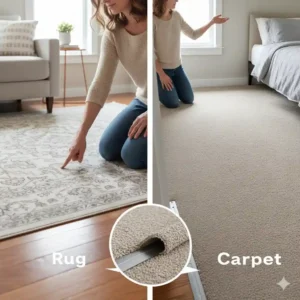When decorating your home, rugs and carpet often come up as essential flooring choices. Many people use these terms interchangeably, but they aren’t quite the same. Both add warmth, texture, and style to your home, yet they differ in size, installation, and functionality. Understanding these differences will help you make the right decision for your space.

1. Definition and Size Difference
The main difference between a rug and a carpet lies in their size and coverage area.
-
Rugs are smaller, movable floor coverings that typically measure under 6×9 feet. They’re perfect for defining spaces or adding an accent to a room.
-
Carpets, on the other hand, generally refer to wall-to-wall installations that cover an entire floor area.
So, if you’re looking for a portable décor element, go for a rug. If you want a permanent, full-coverage flooring solution, a carpet is your best bet.
2. Installation and Portability
Rugs are easy to move, clean, and replace. You can roll them up, switch them between rooms, or even use them seasonally.
Carpets are fixed and require professional installation. They’re attached to the floor using adhesives or tacks, which makes them stable and long-lasting—but not easy to remove.
For renters or people who love to refresh their décor frequently, rugs offer flexibility. For homeowners seeking a cohesive and luxurious look, carpet provides comfort and permanence.
3. Maintenance and Cleaning
When it comes to cleaning, rugs and carpet demand different care methods.
-
Rugs can be lifted, vacuumed, shaken, or spot-cleaned easily. Some smaller rugs are even machine washable.
-
Carpets require regular vacuuming and professional deep cleaning since they can trap more dust and allergens over time.
If convenience is your priority, rugs are easier to maintain. But for a more uniform and polished appearance, carpets are ideal.
 4. Design Variety and Function
4. Design Variety and Function
Rugs are available in endless designs, patterns, and textures—from Persian and oriental styles to modern geometrics. They serve as statement pieces that add character to a room.
Carpets usually feature subtle designs and come in broad color ranges meant to unify the overall décor rather than stand out.
Functionally, rugs help define zones in open-concept spaces, while carpets enhance comfort and insulation throughout the home.
5. Cost and Longevity
In general, rugs are more affordable since they require less material and no installation costs. You can easily replace them as trends change.
Carpets, though more expensive initially, can last for many years if properly maintained, offering excellent long-term value and comfort.
When choosing between rugs and carpet, consider your lifestyle, budget, and how often you like to update your interiors.
FAQs
1. Are rugs and carpet made from the same materials?
Yes, both can be made from wool, nylon, polyester, or synthetic blends, but rugs often feature more decorative weaving styles.
2. Can I use a rug on top of carpet?
Absolutely! Layering rugs on carpet adds texture, depth, and visual interest to your space.
3. Which is better for high-traffic areas?
Rugs are easier to clean and replace, making them great for high-traffic zones like entryways or living rooms.
4. Is carpet warmer than a rug?
Yes, wall-to-wall carpet provides better insulation and warmth, especially in colder climates.
5. Whicht lasts longer—rug or carpet?
A high-quality carpet can last longer due to its permanent installation, but a well-maintained rug can also serve you for years.


Pingback: Find the Perfect Rug Size for Your Room